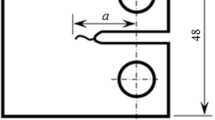Abstract
It has been confirmed that transgranular stress-corrosion cracking (T-SCC) can be discontinuous under slow strain-rate testing, at least for materials which deform by planar slip(i.e., those which have low stacking-fault energy). Interpretation of the load and current transients shows that the crack velocity is on the order of 100 μm/s, depending on the environment — too slow to be explained by a running brittle crack and too fast to be explained by Faradaic dissolution. Support of such an interpretation is given by the agreement between predictions of crack area by mechanical analysis of the load transients (taking into account the elastic displacement of the load train and of the specimen because of both the changing load and the crack advance) and the predictions from analysis of the current transients, as well as the agreement of such predictions with the resulting crack-advance distance determined from fractography. Such agreement follows if the assumption is made that cracking is fully plastic, that is, if deformation accompanies cracking such that the nominal stress on the uncracked cross section is maintained at the flow stress. The significance of this finding with respect to a corrosion-assisted microcleavage model is discussed.
Similar content being viewed by others
References
D.V. Beggs, M.T. Hahn, and E.N. Pugh:Hydrogen Embrittlement and Stress-Corrosion Cracking, ASM, Metals Park, OH, 1984, p. 181.
B.D. Lichter, W.F. Flanagan, J.B. Lee, and M. Zhu: inEnvironment-Induced Cracking of Metals, M.B. Ives and R.P. Gangloff, eds., National Association of Corrosion Engineers, Houston, TX, 1990, pp. 251–59.
W.F. Flanagan, P. Bastias, and B.D. Lichter:Acta Metall. Mater., 1991, vol. 39, pp. 695–705.
B.D. Lichter, M. Bhatkal, and W.F. Flanagan: inParkins Symp. on Fundamental Aspects of Stress-Corrosion Cracking, S. Bruemmer and E.I. Meletis, eds., TMS-AIME, Warrendale, PA, 1992, pp. 279–302.
W.F. Flanagan, Lijun Zhong, and B.D. Lichter:Metall. Trans. A, 1993, vol. 24A, pp. 553–59.
K. Sieradzki and R.C. Newman:Phil. Mag., 1985, vol. 51, pp. 95–132.
K. Sieradzki and R.C. Newman:J. Phys. Chem. Solids, 1987, vol. 48, pp. 1101–13.
M. Zhu: Ph.D Thesis, Vanderbilt University, Nashville, TN, 1990.
L.J. Zhong: Master’s Thesis, Vanderbilt University, Nashville, TN, 1992.
J.B. Lee: Ph.D Thesis, Vanderbilt University, Nashville, TN, 1990.
W.F. Flanagan, Jae Bong Lee, Denis Massinon, Mengke Zhu, and Barry D. Lichter:Proc. Int. Symp. on Environmentally- Assisted Cracking: Science and Engineering, W.B. Lisagor, T.W. Crooker, and B.N. Leis, eds., ASTM STP 1049, ASTM, Philadelphia, PA, 1990, pp. 86–99.
F.A. Champion:Symp. on Internal Stress in Metals and Alloys, Institute of Metals, London, 1948, p. 468; H.L. Logan,J. Res. Nat. Bur. Standards, 1952, vol. 48, pp. 99-105 R.M. Latanision,Atomistics of Fracture, R.M. Latanision and J.R. Pickens, eds., Plenum Press, New York, NY, 1983, NATO Conference Series VI, vol. 5, pp. 3-38.
R.M. Bhatkal: Master’s Thesis, Vanderbilt University, Nashville, TN, 1991.
H. Tada, P.C. Paris, and G.R. Irwin:The Stress Analysis of Cracks Handbook, Del Research Corp., St. Louis, MO, 1985, pp. 2.10–2.12.
J.B. Lee, W.F. Flanagan, and B.D. Lichter:Wear-Corrosion Interactions in Liquid Media, A. Sagues and E.I. Meletis, eds., TMS-AIME, Warrendale, PA, 1991, pp. 19–35.
Author information
Authors and Affiliations
Rights and permissions
About this article
Cite this article
Flanagan, W.F., Wang, M., Zhu, M. et al. A fully plastic microcracking model for transgranular stress-corrosion cracking in planar-slip materials. Metall Mater Trans A 25, 1391–1401 (1994). https://doi.org/10.1007/BF02665472
Received:
Issue Date:
DOI: https://doi.org/10.1007/BF02665472




